
Bryolymnia is a genus of moths of the family Noctuidae erected by George Hampson in 1908.

Cryphia is a genus of moths of the family Noctuidae. The genus was erected by Jacob Hübner in 1818.

Euxoa is a genus of moths of the family Noctuidae raised to Genus by the German entomologist, Jacob Hübner. The Genus is mostly confined to dry and semi dry areas in the Northern Hemisphere. There 130 species in Eurasia, a few in Africa, and 175 in North America. There are no species in the Genus in South-East Asia or in Australia. In North America, most species are found in Western regions. Of the North American species, 4 are endemic to Mexico. There is one species recorded from Chile, but this may be a mislabeled specimen. In real terms, species numbers do not equal species abundance. Some areas with few species have large numbers of the ones that do live there.

Sympistis dunbari is a moth of the family Noctuidae first described by Leon F. Harvey in 1876. It is found in wet coastal forests of North America, west of the Cascade Mountains, as far north as British Columbia, south to Utah, California and Arizona.

Grotella septempunctata is a moth in the genus Grotella, of the family Noctuidae. The species was first described by Leon F. Harvey in 1875. It can be found in North America, from Texas to Colorado.
Euxoa aequalis is a moth of the family Noctuidae first described by Leon F. Harvey in 1876. It is found in Canada from British Columbia, Alberta, Saskatchewan and Yukon, south into the United States, where it has been recorded from Colorado, Wyoming and California.
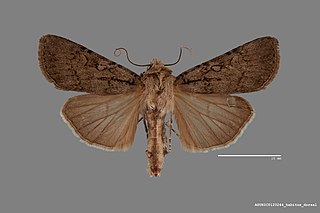
Euxoa choris is a moth of the family Noctuidae first described by Leon F. Harvey in 1876. It is found in North America from south-western Saskatchewan, central Alberta and south-central Yukon, south to New Mexico, Arizona and California.

Bryolymnia viridimedia is a moth of the family Noctuidae first described by John Bernhardt Smith in 1905. It is found from south-eastern Arizona southward in the Sierra Madre Occidental to the Mexico City area.

Bryolymnia bicon is a moth of the family Noctuidae first described by Herbert Druce in 1889. It is found from Veracruz in central-eastern Mexico southward to Costa Rica.

Bryolymnia marti is a moth of the family Noctuidae first described by Richard Holland in 2010. It is found from central New Mexico and east-central Arizona southward to Durango in northern Mexico.

Bryolymnia mixta is a moth of the family Noctuidae first described by Donald Lafontaine and J. Walsh in 2010. It is known only from the Patagonia Mountains in south-eastern Arizona.
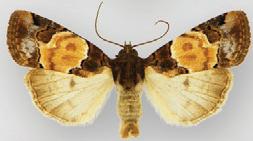
Bryolymnia biformata is a moth of the family Noctuidae first described by Donald Lafontaine and J. Walsh in 2010. It is known only from the Huachuca, Patagonia, and Santa Rita Mountains in south-eastern Arizona.

Bryolymnia anthracitaria is a moth of the family Noctuidae first described by Clifford D. Ferris and Noel McFarland in 2007. It is known only from south-eastern Arizona where it has been collected in oak scrub grassland.

Bryolymnia poasia is a moth of the family Noctuidae first described by William Schaus in 1911. It is found in Costa Rica.

Bryolymnia semifascia, the half-banded bryolymnia, is a moth of the family Noctuidae. The species was first described by John Bernhardt Smith in 1900. It is found in the US from northern Colorado and southern Utah southward to south-eastern Arizona and south-central New Mexico.

Bryolymnia picturata is a moth of the family Noctuidae first described by William Schaus in 1894. It is found in south-eastern Mexico.
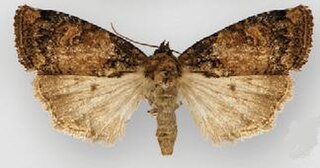
Bryolymnia ensina is a moth of the family Noctuidae first described by William Barnes in 1907. It occurs in coniferous forests from south-eastern Arizona and south-western New Mexico southward in the Sierra Madre Occidental to the state of Durango in Mexico.
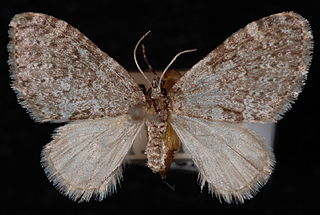
Acasis viridata, the olive-and-black carpet, is a species of moth belonging to the family Geometridae. It was described by Packard in 1873. It is found from Newfoundland to British Columbia and the adjacent northern part of the United States, south in the east to Florida, and south in the west to Colorado and Oregon.
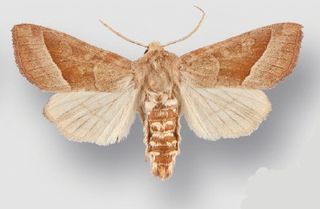
Hydraecia obliqua is a moth in the family Noctuidae first described by Leon F. Harvey in 1876. It is found in western North America, east to the Sierra Nevada in California and the crest of the Cascade Range in Oregon and Washington. It occurs continuously on the coast north to south-western British Columbia, with a disjunct northern population at Terrace, British Columbia. The habitat consists of the riparian zone along creeks and rivers of coastal rainforests, as well as oak savanna, mixed hardwood forests and valley grasslands.
Papaipema appassionata, the pitcher plant borer, is a species of moth described by Leon F. Harvey in 1876. It is native to North America, where it has been recorded from Florida, Maine, Maryland, Massachusetts, Michigan, Minnesota, New Brunswick, Quebec, Rhode Island, South Carolina and Wisconsin. It is listed as threatened in the US state of Connecticut.










